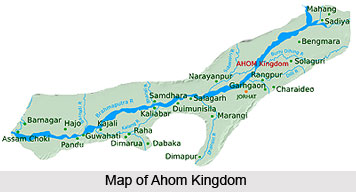 Suhenphaa was the ruler of Ahom kingdom from 1488 CE to 1493 CE. Ahom kingdom greatly stretched its boundaries during Suhenphaa which led to his conflicts with the Kachari kingdom and the Nagas. He conquered over the Nagas whereas in case of Kacharis he faced defeat. An Ahom of Tairungban clan assassinated Suhenphaa.
Suhenphaa was the ruler of Ahom kingdom from 1488 CE to 1493 CE. Ahom kingdom greatly stretched its boundaries during Suhenphaa which led to his conflicts with the Kachari kingdom and the Nagas. He conquered over the Nagas whereas in case of Kacharis he faced defeat. An Ahom of Tairungban clan assassinated Suhenphaa.
Coronation of Suhenphaa
Suhenphaa was born to the Ahom king Susenphaa who ruled over the Ahom kingdom for about 49 years. The reign of Susenphaa was marked by prosperity and peace. Suhenphaa succeeded the throne in 1488 CE after the death of his father.
Expedition of Suhenphaa against Nagas
During the rule of Suhenphaa`s father, the Tangsu Nagas were defeated once but they again started their expedition during the reign of Suhenphaa. They started raiding their villages along the Brahmaputra plains and imprisoned common people of Assam. To handle the activities of the Tangsu Nagas, Suhenphaa dispatched a group of Ahom soldiers led by Taokangbanrek Borgohain. However the Ahom forces could not overpower the Tangsu Nagas and were defeated and Taokangbanrek Borgohain, the commander of the force was later beheaded by them. His head was taken to the native village by the Nagas as a prize of the conquered battle. Afterwards Suhenphaa appointed another huge group of soldiers under the commandership of Nangraang Borgohain to fight against Tangsu Nagas. This was followed by a fierce war in which the Ahoms emerged as the victors and the Nagas submitted themselves to the Ahoms. After the defeat the Tangsu Nagas also agreed for the payment of an annual tribute to the ruler of Ahom kingdom. A number of Naga prisoners were brought along with Nangraang Borgohain which symbolized their victory. Later, with Suhenphaa`s permission, he settled the prisoners in different regions of Ahom kingdom.
Expedition of Suhenphaa against Kacharis
With the aim of expanding the kingdom Suhenphaa decided to invade the Kachari kingdom, towards the downstream of Brahmaputra River. Kacharis who were the inhabitants of upper Assam strongly opposed the Ahom invasion in their territory. Suhenphaa sent his army and ordered one of his officers Chelaoseng Neog to build a fortification at Tongsu in the Kachari territory. The Kacharis however did not oppose this construction and this worked as an encouragement for the Ahoms to invade the territory further inwards. Suhenphaa then dispatched another group of force led by Khunlung Burhagohain. This move was strongly resisted by the Kacharis and the Ahom army got defeated. About 150 soldiers and an Ahom commander Jiyeumung Neog were killed in this battle and the rest of the Ahom army was chased up to the Dikhou River. Khunlung Burhagohain swam across the river leaving behind his elephants and other valuables. On the advice of nobles of the kingdom Suhenphaa then urged for peace with the Kachari king and sent a princess along with twelve female slaves and two elephants as dowry. However according to some chronicles, the consequence of the battle was indecisive and for making peace the Kacharis demanded a portion of Ahom territory.
Assassination of Suhenphaa
An Ahom belonging to Tairungban clan namely Lantarunban was once caught for stealing paddy from the royal granary. When he along with his companions were punished and fined for their deed, they pledged to take revenge from the king. Later in 1493 CE Lantarunban and his friends were appointed for some repair work in the royal palace. While working, Lantarunban had hid a spear in the hollow of a bamboo and when the king arrived to check the progress of the work, he was stabbed to death by the spear. Some records also say that the Khunlung Burhagohain instigated the king`s murder.
There were three sons of Suhenphaa and the eldest among them was Supimphaa who later succeeded the throne as king. During the reign of Suhenphaa, Ahom kingdom expanded greatly. Suhenphaa was also known to be a strict administrator who did not spare anyone who was found guilty of a crime. This characteristic of Suhenphaa however also fetched him a number of enemies who later plotted his assassination.



















